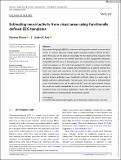Estimating neural activity from visual areas using functionally defined EEG templates
Abstract
Electroencephalography (EEG) is a common and inexpensive method to record neural activity in humans. However, it lacks spatial resolution making it difficult to determine which areas of the brain are responsible for the observed EEG response. Here we present a new easy-to-use method that relies on EEG topographical templates. Using MRI and fMRI scans of 50 participants, we simulated how the activity in each visual area appears on the scalp and averaged this signal to produce functionally defined EEG templates. Once created, these templates can be used to estimate how much each visual area contributes to the observed EEG activity. We tested this method on extensive simulations and on real data. The proposed procedure is as good as bespoke individual source localization methods, robust to a wide range of factors, and has several strengths. First, because it does not rely on individual brain scans, it is inexpensive and can be used on any EEG data set, past or present. Second, the results are readily interpretable in terms of functional brain regions and can be compared across neuroimaging techniques. Finally, this method is easy to understand, simple to use and expandable to other brain sources.
Citation
Poncet , M & Ales , J M 2023 , ' Estimating neural activity from visual areas using functionally defined EEG templates ' , Human Brain Mapping , vol. 44 , no. 5 , pp. 1846-1861 . https://doi.org/10.1002/hbm.26188
Publication
Human Brain Mapping
Status
Peer reviewed
ISSN
1065-9471Type
Journal article
Description
This work was supported by BBSRC grant BB/N018516/1 and Wellcome Trust ISSF 204821/Z/16/Z.Collections
Items in the St Andrews Research Repository are protected by copyright, with all rights reserved, unless otherwise indicated.

